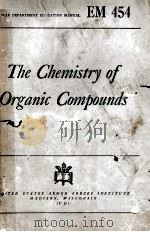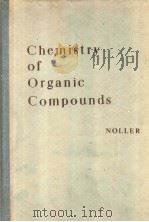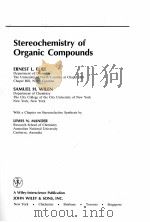《RADIATION CHEMISTRY OF ORGANIC COMPOUNDS》
| 作者 | A.J.SWALLOW 编者 |
|---|---|
| 出版 | 未查询到或未知 |
| 参考页数 | 380 |
| 出版时间 | 没有确切时间的资料 目录预览 |
| ISBN号 | 无 — 求助条款 |
| PDF编号 | 811654758(仅供预览,未存储实际文件) |
| 求助格式 | 扫描PDF(若分多册发行,每次仅能受理1册) |

CHAPTER Ⅰ.GENERAL INTRODUCTION1
A.Net Chemical Effects Produced by Radiation2
B.Mechanism of the Interction of High-Energy Radiation with Matter4
1.X-and γ-rays4
(a)Pair production4
(b)Compton scattering5
(c)Photoelectric absorption5
2.Fast Electrons5
3.Heavy Particles9
(a)Neutrons9
(b)Charged particles9
4.Linear Energy Transfer10
C.Transient Entities Formed by Radiation11
1.Ions12
(a)Ionization of gases13
(b)Ionization of liquids15
(c)Ionization of solids15
(d)Reactions of ions16
2.Excited Molecules17
(a)Formation of excited molecules17
(b)Energy transfer between molecules18
(c)Reactions of excited molecules19
3.Free Radicals19
4.Unstable Chemicals22
D.Summary and Conclusions22
CHAPIER Ⅱ.EXPERIMENTAL METHODS23
A.Radiation Sources23
1.Electrical Machines23
(a)Fast electrons23
(b)X-rays27
(c)Heavy particles28
2.Radioactive Sources29
(a)Beta-particles29
(b)γ-rays30
(c)He? particles32
B.Preparation,Irradiation and Analysis of Samples33
1.Purification of Chemicals33
2.Irradiation Conditions35
3.Analysis35
4.Yidlds36
C.Dosimetry36
1.Units36
2.Calorimetry36
3.Ionization Methods38
4.Calculation from Source Strength41
5.Charge Collection41
6.Chemical Methods41
7.Personnel Monitoring43
D.Summary and Concluslons44
CHAPTER Ⅲ.WATER AND AQUEOUS SYSTEMS45
A.Pure Water45
B.Ferrous Sulphate Sohutions48
1.Reaction Mechanism50
2.Use of Ferrous Suiphate System to Determine Monlecular and Radical Yields for Inadiated Water52
3.Determination of Relative Rate Constants54
C.Solutions Containing Ferrous or Ferric Ions and Organic Substances55
1.Ferric Ions in the Presence of Organic Substances but in the Absence of Oxygen56
2.Ferrous Ions in the Presence of Organic Substances and Oxygen58
3.Complexes of Ferrous or Ferric Ions59
D.Summary and Conclusions60
CHAPTER Ⅳ.ALIPHATIC COMPOUNDS61
A.Saturated Hydrocarbons61
1.Pure Hydrocarbons61
(a)Methane61
(b)Other hydrocarbons63
2.Mixtures of Hydrocarbons with Other Substances75
(a)Mixtures in which the hydrocarbons predominates75
(b)Mix-tures in which the hydrocarbon in the minor constituent78
B.Unsaturated Hydrocartons79
1.Pure Ethylenic Hydrocarbons79
2.Ethylenic Hydrocarbons Mixed with Other Substances82
3.Pure Acetylenic Hydrocarbons83
4.Acetylenic Hydrocarbons Mixed with Other Substances84
C.Vinyl and Related Compounds85
1.Polymerization in the Liquid Phase86
(a)Polymerization in mintures86
(b)Polymerization of pure liquids89
2.Graft Polymerization90
3.Polymerization in the Solid Phase92
4.Polymerization in the Vapour Phase93
D.Halides94
1.Chlorides94
2.Bromides96
3.Iodides98
4.Use of Halides in Dosimetry101
E.Alcohols and Hydroxy Acids103
1.Alcohols103
2.Hydroxy Acids108
F.Ethers108
G.Aldehydes and Ketones109
H.Carboxylic Acids111
1.Pure Acids111
2.Aqueous Solutions113
(a)Formic acid113
(b)Other acids116
I.Esters118
J.Amines120
K.Nitro Compounds121
L.Summary and Conclusions121
CHAPTER Ⅴ.AROMATIC COMPOUNDS124
A.Pure Aromatic Compounds124
1.Benzene124
2.Other Hydrocarbons127
3.Compounds Other Than Hydrocarbons130
B.Energy Transfer in Mixtures130
C.Reactions in Mixtures137
1.Mixtures with Other Organic Compounds137
2.Mixtures with Inorganic Compounds138
(a)Halogenation138
(b)Oxidation140
(c)Miscellaneous reactions140
(d)Reactions in aqueous solutions141
D.Summary and Conclusions146
CHAPTER Ⅵ.POLYMERS148
A.General Features in the Irradiation of Polymers148
1.Cross-linking,Degradation and Other Changes148
2.Relation between Chemical and Physical Changes151
3.Formation of Free Radicals153
4.Use of Polymers for Dosimetry154
B.Polythene155
1.Chemical Changes155
2.Reaction Mechanism160
C.Other Polymers162
1.Vinyl Polymers162
(a)Polypropylene162
(b)Poly(isobutylene)162
(c)Poly(vinyl chloride)163
(d)Polytetrafluorethylene and polymonochlorotrifluorethy-lene164
(e)Poly(acrylonitrile)and poly(α-methacrylonitrile)164
(f)Polyacrylates164
(g)Poly(methyl methacrylate)165
(h)Polystyrene166
2.Polymers Other Than Vinyl Polymers167
(a)Rubber167
(b)Silicones168
(c)Polyamides169
(d)Other polymers169
D.Polymers in Solution169
E.Summary and Conclusions173
CHAPTER Ⅶ.DYESTUFFS175
A.Methylene Blue175
1.Methylene Blue in the Presence of Other Organic Substances175
2.Methylene Blue in the Absence of Other Organic Substances178
B.Other Dyes181
C.Summary and Conclusions184
CHAPTER Ⅷ.SOME SUBSTANCES OF BIOLOGICAL INTEREST186
A.Steroids186
1.Irradiation of Solid Stetoids186
2.Irradiation of Steroids in Solution187
B.Carbohydrates and Polysaccharides196
1.Carbohydrates196
2.Polysaccharides198
(a)Aqueous solutions199
(b)Dry polysaccharides199
C.Amino Acids and Peptides200
1.Glycine200
(a)Irradiation of the dry substance200
(b)Irradiation in aqueous solution201
2.Other Aliphatic Amino Acids203
(a)Irradiation of the dry substance203
(b)Irradiation in aqueous solution203
3.Aromatic Amino Acids205
4.Peptides207
D.Thiols and Disulphides207
1.Thiols208
2.Disulphides210
E.Proteins and Enzymes210
1.Irradiation of Proteins and Enzymes in the Dry State211
(a)Changes in chemical and physical properties211
(b)Changes in biological properties212
2.Irradiation of Proteins and Enzymes in Aqueous Solution213
(a)Changes in chemical and physical properties213
(b)Inactiva-tion of enzymes218
(c)Mechanism of indirect action on proteins and enzymes220
(d)Protection of proteins and enzymes221
(e)Mis-cellaneous effects223
F.Respiratory Proteins,Vitamins and Coenzymes224
1.Respiratory Proteins224
(a)Cytochrome-c224
(b)Haemoglobin,myoglobin and hacmo-cyanin225
2.Vitamins and Coenzymes226
(a)Coenzyme I226
(b)Vitamins of the B group228
(c)Vitamin C230
(d)Fat-soluble vitamins230
(e)Growth factors231
G.Nucleic Acids and Related Compounds231
1.Phosphate Esters232
2.Irradiation of Nucleic Acids in Aqueous Solution232
(a)Chemical changes233
(b)Decrease in molecular weight234
(c)Explanation of the decrease in molecular weight235
3.Irradiation of Dry Nucleic Acids238
4.Changes in Biological Properties of Nucleic Acids239
5.Irradiation of Nucleoproteins239
H.Summary and Conclusions240
CHAPTER Ⅸ.RADIATION CHEMISTRY AND OTHER FIELDS242
A.The History of the Earth243
1.The Origin of Organic Compounds243
2.The Origin of Petroleum245
B.Radiobiology and Radiotherapeutics246
1.Sensitivity of Biological Systems to Irradiation247
2.Chemical Modification of Radiation Effect250
3.Relative Biological Effectiveness251
C.Use of Radiation to Determine Molecular Size254
D.The Use of Radiation to Sterilize Pharmaceutical Products or to Preserve Food257
1.Principles of Radiation Treatment257
2.Radiation Damage259
E.Economic Aspects of the Use of Radiation261
1.Machine-produced Radiation262
2.Radloactive Sources263
3.Nuclear Reactors265
F.Applications of Radiation in Chemical Industry267
1.Advantages of Radiation Processing267
2.Feasible Radiation Processes268
3.The Cross-linking of Polythene269
G.The Resistance of Materials to Radiation271
1.Coolant-moderators271
2.Processing Materials272
3.Lubricants and Organic Liquids274
4.Plastics and Elastomers277
H.Summary and Conclusions283
CONCLUSIONS285
BIBLIOGRAPHY289
SUBIBCT INDEX355
NAME INDEX363
《RADIATION CHEMISTRY OF ORGANIC COMPOUNDS》由于是年代较久的资料都绝版了,几乎不可能购买到实物。如果大家为了学习确实需要,可向博主求助其电子版PDF文件。对合法合规的求助,我会当即受理并将下载地址发送给你。
高度相关资料
-

- THE CHEMISTRY OF ORGANIC COMPOUNDS
- 1944 THE MACMILLAN COMPANY
-

- COMPREHENSIVE ORGANIC CHEMISTRY The Synthesis and Reactions of Organic Compounds Volume 5 Biological
-

- IDENTIFUCATION OF ORGANIC COMPOUNDS
- JOHN B.ENTRIKIN"
-

- THE CHEMISTRY OF ORGANIC SILICON COMPOUNDS PART 1
- JOHN WILEY & SONS
-

- COMPREHENSIVE ORGANIC CHEMISTRY THE SYNTHESIS AND REACTIONS OF ORGANIC COMPOUNDS VOLUME 5 BIOLOGICAL
- 1979 PERGAMON PRESS
-

- INORGANIC CHEMISTRY SERIES TWO VOLUME 6 TRANSITION METALS-PART 2
- 1975 BUTTERWORTHS UNIVERSITY PARK PRESS
-

- COMPREHENSIVE ORGANIC CHEMISTRY THE SYNTHESIS AND REACTIONS OF ORGANIC COMPOUNDS VOLUME 3
- 1979 PERGAMON PRESS
-

- COMPREHENSIVE ORGANIC CHEMISTRY THE SYNTHESIS AND REACTIONS OF ORGANIC COMPOUNDS VOLUME 4 HETEROCYCL
- 1979 PERGAMON PRESS
-

- COMPREHENSIVE ORGANIC CHEMISTRY THE SYNTHESIS AND REACTIONS OF ORGANIC COMPOUNDS VOLUME 1
- 1979 PERGAMON PRESS
-

- THE ORGANIC CHEMISTRY OF ALIPHATIC NITROGEN COMPOUNDS
- 1994 CLARENDON PRESS
-

- Organic Chemistry Series One Volume 3:Aromatic Compounds
- 1973 MTP MEDICAL AND TECHNICAL PUBLISHING CO.LTD
-

- Fundamentals of Radiation Chemistry
- 1999 ACADEMIC PRESS
-

- CHEMISTRY OF ORGANIC FLUORINE COMPOUNDS
- 1961 PERGAMON PRESS LTD
提示:百度云已更名为百度网盘(百度盘),天翼云盘、微盘下载地址……暂未提供。➥ PDF文字可复制化或转WORD

